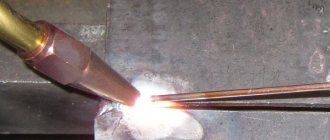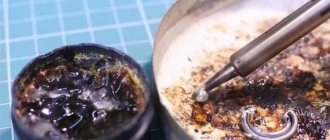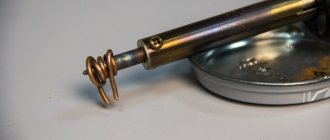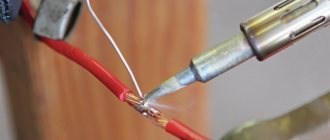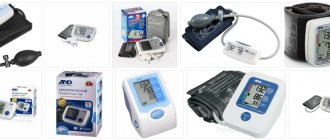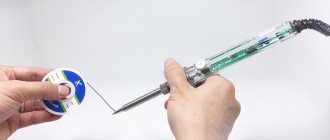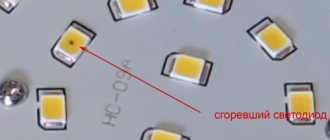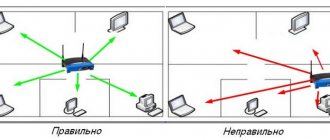Application of aluminum
The widespread use of aluminum products lies primarily in the fact that it is a light metal. Aluminum is widely used in electrical engineering because it has excellent electrical conductivity.
For household needs, pots, cans, colanders, and mugs are made from this metal. Pure aluminum is used to produce foil used for electrolytic capacitors. It can also be used in the production of radiators.
However, soldering this metal can cause a lot of problems. This is explained by the fact that upon slight interaction with air, the surface of aluminum is covered with a thin but hard oxide film. It protects aluminum from further oxidation, but during the soldering process it creates a difficult barrier to overcome.
There are several methods to solve this problem, for example, soldering with rosin, but the best results are obtained by using fluxes specially designed for this.
Other methods for joining copper and aluminum
For connecting dissimilar wires, in this case, copper and aluminum, there are other methods that are fully justified, as confirmed by many years of practice.
Crimping method
The soldering method for connecting aluminum and copper wires is not always suitable, and the reasons may be different. Firstly, you simply may not have flux, and the connection needs to be made urgently. Secondly, it may not be possible to connect to ≈220 V, and thirdly, there may be no free space to reach with a soldering iron. For example, in an electrical distribution box (dose), all twists must be well insulated, but the usual rag tape is not suitable in this case, since it allows oxygen to pass through, which will contribute to the oxidation of aluminum and, as a result, burnout of the twist. Therefore, one of the most optimal insulation options in such situations will be a sleeve - a fragment of the required length, cut from a heat-shrinkable tube.
Heat shrink is applied to the twist so that it captures the insulation on one and the other wire at least a centimeter at a time. First, the sleeve is put on one of the wires, then a tight twist is made, the thermal strip is moved so that it is in the center, but at the same time captures the insulation on both sides. After this, all that remains is to heat up the heat-shrinkable tube, and it will crimp both the insulation on both sides and the twist itself. It is usually heated with an ordinary burning match, and the sleeve cools down in 1-2 minutes. After this, the access of oxygen to the connection is stopped.
Terminal blocks
Terminal blocks, or, as electricians call them, terminal blocks, are used to connect homogeneous and dissimilar conductive metal cores. For joining in a plastic block, bolted or clamp terminals are used, which ensure 100% contact and the complete absence of the influence of aluminum oxidation on copper. Between the terminals there is a shunt plate made of a neutral metal (usually tinned copper or brass), which is not affected by the oxide film. The most important thing in the terminal block is a good clamping of both wires, which guarantees a long service life. The only contraindication for such a connection is high air humidity. If this happens in such a room, then it is better to use heat shrink.
Bolted connection
The rules for the construction of electrical installations (PUE) state that ordinary twisting of two elements of electrical circuits with different chemical compositions is prohibited. Such connections can only be made using soldering or other methods indicated above - using terminal blocks, heat shrink tubing or bolted connections. The last option is extremely simple: it requires a bolt, one nut and three washers, as shown in the top photo. But this method has a serious drawback - it is only suitable for overhead lines, since there is no insulation on such a connection. Of course, as an option, such a design with a small bolt can be assembled in a distribution box (dose) and secured with rag tape, but this is rather the exception than the rule.
Soldering problems
The melting point of aluminum does not exceed 660 degrees. The consequence of this is the use, for economic reasons, of welding machines that do not have too much power.
However, there is an oxide film on the surface of aluminum that must be removed before starting the welding process. But to melt it requires heating to a temperature of 2000 degrees. When this value is reached, not only the oxide film will be destroyed, but also the metal itself, which will lead to a deterioration in the quality of the welded joint. In addition, the oxide film can be restored after it has melted. Due to the stability of the oxide film, which has weak adhesion to solder, conventional solder has difficulty sticking to the surface of the part.
Aluminum soldering flux solves this problem. When applied to the welding area, it will block the passage of air into this area, which will lead to a weakening of the negative effects of the oxide film. Compared to other metals, such as iron and zinc, aluminum is more active - a cleaned part can instantly become covered again with an oxide film. Therefore, flux intended for aluminum parts is also required to act quickly.
Active flux for low-temperature soldering of aluminum will quickly dissolve the oxide film on the surface of products that interferes with the normal spreading of solder. In addition, zinc is added to the solder intended for joining aluminum products, which has the ability to dissolve well in aluminum.
A connection based on solder containing zinc has greater strength. By combining the appropriate solder and a universal flux for soldering aluminum, you can obtain a high-quality connection without much difficulty.
Features of the substance
Active flux for soldering aluminum has significant differences from similar substances used to join products made of steel, brass and copper, just as the properties of these metals themselves differ. The flux composition contains substances that can easily dissolve the oxide film on the surface of aluminum. For soldering aluminum products, fluxes of various numbers are used.
The simplest are fluxes No. 8 and 9, however, their activity is not too great compared to those that include fluorine compounds. The choice is made based on the characteristics of a particular job. There are fluxes that are used for welding joints of parts without prior preparation. The most common type of flux is F-64.
The composition of the flux for aluminum soldering, number F-64, contributes to its increased activity, which makes it possible to successfully clean even uncleaned surfaces from the oxide film. The solution is colorless or light yellow.
How to solder?
Before proceeding with direct soldering, it is necessary to properly prepare the surface of the wires. First, the surface must be degreased. This is achieved by treating the soldering area with acetone, gasoline or another type of solvent.
If there is no flux on hand, it is necessary to mechanically remove the oxide film from the surface of the wire. This is done using sandpaper, a steel brush, etching fluid, and so on.
It must be remembered that it will not be possible to remove the abrasive film by mechanical means, since a new, albeit thinner, oxide film immediately forms on the metal surface due to contact with air. Flux is much better in this regard, as it removes all the oxide film and prevents air from penetrating the metal.
When the oxide is removed, the wires are fixed, heated with a soldering iron and solder is applied to the heated area.
Solders used
When welding products made of aluminum, it is recommended to use solders from the tin-lead group. The highest quality connection can be obtained if you use a type of solder that contains elements such as silicon, zinc, and copper. The addition of additives significantly improves the quality of the solder - they lower its melting point, increase wettability, and make it more durable.
These types of solders are produced by domestic industry and foreign manufacturers. Tin-lead solders have the lowest melting point. One of the most common brands of solder for aluminum welding is HTS-2000. Experienced welders say that HTS-2000 solder should only be used with flux to obtain a high-quality connection.
Good substances in this area also include solder from the French company Castolin 192FBK, as well as Castolin 1827 solder, used when joining parts made of aluminum and copper. The domestic analogue of HTS-2000 is SUPER A+ solder, manufactured in Novosibirsk, which is used in conjunction with SUPER FA flux.
Aluminum soldering Fluxes Solders
Phone disassembly tools
Hello my dear readers! I became interested in aluminum soldering about 5 years ago, when I urgently had to solder the cooling radiator of my Grasshopper. Below I will show a photo of it and the place of soldering on the radiator, which is still working. Recently I was asked what is the best way to solder aluminum? I decided to read all the relevant articles and personal opinions on aluminum soldering and put it on one page. This is how this article was born. Go!
Why is aluminum difficult to solder?
Anyone who has tried to solder aluminum knows that ordinary solder does not stick to it at all. This is all due to a stable film of aluminum oxide, which has poor adhesion to solder. Moreover, this film covers aluminum and its alloys very quickly. Before you have time to clean it, the light metal has already oxidized. Therefore, all methods of aluminum soldering first deal with the film, and then take care of adhesion.
Aluminum oxide (Al2O3) in mineralogy is called corundum. Large transparent corundum crystals are gemstones. Due to impurities, corundum comes in different colors: red corundum (containing chromium impurities) is called ruby, and blue corundum is called sapphire. Now it is clear why the oxide film does not solder at all.
Best tubular solder Kaina How to remove oxide film?
The aluminum oxide film is removed in two ways: mechanical and chemical. Both methods remove aluminum oxide in an airless environment, that is, without access to oxygen. Let's start with the most difficult, but most correct and reliable method of removal - chemical.
Precipitate copper or zinc
The chemical soldering method is based on the preliminary deposition of copper or zinc onto aluminum by electrolysis. To do this, apply a concentrated solution of copper sulfate to the desired location and connect the negative of the battery or laboratory power source in a free place. Then take a piece of copper (zinc) wire, connect a plus to it and immerse it in the solution.
Through the process of electrolysis, copper (zinc) is deposited onto the aluminum and adheres to it at a molecular level. Then aluminum is soldered on top of the copper. True, it is not clear how all this passes through the oxide barrier. I think that this instruction skips the step of scratching aluminum under a film of copper sulfate or other chemical exposure. Although the practice from the video below shows that you don’t have to scratch.
After deposition, copper or zinc can be tinned without problems using standard fluxes. It seems to me that this method makes sense to be used on an industrial scale and for particularly critical work. Use oil without water
The second most difficult method is to remove the aluminum oxide under the oil film. In this case, the oil should contain a minimum of water - transformer or synthetic oil will do. You can hold the oil at a temperature of 150 - 200 degrees for several minutes so that the water evaporates from it and it does not splash when heated.
Under the oil film, you also need to remove the oxide. You can rub it with sandpaper, scratch it with a scalpel, or use a serrated tip. When I needed to solder the engine cooling radiator, I used the chip method. We take a nail, saw it with a file to get steel shavings.
Next, apply oil to the soldering area and sprinkle chips. Using a soldering iron with a wide tip, we try to rub the soldering area so that there are shavings between the tip and the aluminum. In the case of a massive radiator, I additionally heated the tinning area with a hot air soldering station.
Then we take a drop of solder onto the tip, immerse it in oil at the soldering site and rub it again. For better tinning, you can add rosin or other flux. The so-called surfacing under a layer of flux occurs. The video shows a good example of soldering aluminum with oil.
Solder with active flux
There are separately developed active fluxes for soldering aluminum. They usually contain acids (orthophosphoric acid, acetylsalicylic acid) and salts (sodium salt of boric acid). Strictly speaking, rosin also consists of organic acids, but in practice it gives a weak result on aluminum.
Due to their activity, acid fluxes must be washed off after soldering. After the first wash, you can additionally neutralize the acid with alkali (soda solution) and wash it a second time.
Active fluxes give good and quick results, but inhaling the vapors of this flux is strictly prohibited. Vapors irritate mucous membranes, damage them, or can enter the bloodstream through the respiratory tract.
Fluxes for aluminum soldering Soldering station Hakko 936 with a set of tools
Let's look at all the common fluxes for soldering aluminum.
Rosin
Yes, you can solder aluminum with rosin. Yes, in an airless environment without an oxide film. Even in this situation, more time is usually spent than with active fluxes. Yes, it's not professional, but it solders.
Powder flux
Powder fluxes for soldering aluminum are often used in conjunction with a gas torch. At the same time, everyone writes that oxygen cannot be added to the flame. Because of this, the effectiveness of the flux is reduced due to the oxidation of aluminum. Powder fluxes often used are the following:
- Active flux F-34A. Made according to TU 48-4-229-87 and contains 50% potassium chloride, 32% lithium chloride, 8% zinc chloride, 10% sodium fluoride. This composition is successfully used with low-melting and high-melting solders containing many chemical additives. It dissolves well in water and is hygroscopic.
- Borax (sodium salt of boric acid) is a powder that melts at a temperature of 700 degrees and becomes viscous. It is cheap and dissolves in water. It washes off well with citric acid.
- Acetylsalicylic acid. I once tried soldering with an acetylsalicylic acid tablet - the fumes severely burned my eyes and nose. In general, a dangerous thing! It is better to solder with active liquid flux.
- Active solder fat - although not a powder, is a solid flux that consists of paraffin, petroleum jelly, deionized water, zinc chloride and ammonium chloride. Its structure is created by paraffin, so usually the soldering iron is lowered into a jar or solder fat is crumbled into the soldering area. It solders quite well, especially if the tinning area is heated. It is better not to inhale the vapors and wash them off after soldering, because they corrode and oxidize metals over time. However, like any active flux.
Liquid flux
Liquid fluxes are good because they can be applied in a thin layer. They evaporate more actively and often have scalding vapors. More suitable for soldering with a soldering iron.
- Flux F-64 contains tetraethylammonium, fluorides, deionized water, wetting additives and corrosion inhibitors .
It is capable of destroying a strong oxide film of considerable thickness, which means it is suitable for soldering large workpieces. Suitable for soldering aluminum, galvanized iron, copper, beryllium bronze, etc. - Flux F-61 contains triethanolamine, zinc fluoroborate, ammonium fluoroborate. It can be recommended for low-temperature soldering at 250 degrees or tinning of products made of aluminum alloys.
- Castolin Alutin 51 L contains 32% tin, lead and cadmium. This composition works best when using solders from the same manufacturer at temperatures of 160 degrees and above.
- There are other liquid fluxes, but I won’t list them - they should all be equally good.
Aluminum Solder Solders
for aluminum soldering are often made mostly of aluminum or zinc. Manufacturers add various additives to the composition to improve the properties of solders: lower the melting point, improve strength, wettability, etc. Solders come to us from France, Germany and America. I’ll also tell you about domestic ones.
Solder HTS-2000
This is the most advertised solder. Soldering aluminum with it is very simple. Watch the promotional video about soldering HTS-2000 from New Technology Products (USA). They say it is even better and stronger than aluminum. But it is not exactly.
And here is the real experience of soldering with HTS-2000 solder. The solder doesn't stick well at first, but then it seems to work. A pressure test showed that the soldering area was etching. There is an opinion that HTS-2000 should only be soldered with flux. Draw your own conclusions. Castolin solder
Castolin 192FBK solder consists of 2% aluminum and 97% zinc. 192FBK is practically the only solder for soldering aluminum to aluminum in the list of offers of the French company Castolin. There is also AluFlam190 solder, but it is intended for capillary soldering and does not have flux inside. The line also includes Castolin 1827 solder, designed for soldering aluminum with copper at a temperature of about 280 degrees.
Castolin 192fbk tubular solder contains flux in the core, so you can solder without the recommended Castolin Alutin 51 L liquid flux. The video below shows the soldering process. Good solder - you can buy it for 100 - 150 rubles. per rod weighing 10 grams.
Solder Chemet
Chemet Aluminum 13 solder is used for welding aluminum and its alloys with a melting point above 640 degrees. It consists of 87% aluminum and 13% silicon. The solder itself melts at a temperature of about 600 degrees. Cost - about 500 rubles. for 100 grams, in which there are as many as 25 rods.
Its older brother Chemet Aluminum 13-UF has flux inside the tube, but costs more - 700 rubles. for 100 grams and 12 rods.
I didn’t find any sane videos on soldering with this solder. Of course, this list of solders is not exhaustive. There are also Harris-52, Al-220, POTs-80, etc.
Domestic solders
- POS-61. Why not? When I was soldering an aluminum radiator, this was the only one I had on hand. And it has held up well for 5 years.
- Aluminum solder 34A - for soldering with a gas-flame torch, in a furnace in a vacuum or with immersion in a molten salt of aluminum and its alloys, except D16 and containing > 3% Mg. Melts at 525 degrees. Solders aluminum alloys AMts, AMg2, AM3M well. For 100 grams you will have to pay about 700 rubles.
- Grade A solder is manufactured in accordance with TU 48-21-71-89 and consists of 60% zinc, 36% tin and 2% copper. Melts at a temperature of 425 °C. 1 rod weighs about 145 grams and costs about 400 rubles.
- SUPER A+ is used with SUPER FA flux and is manufactured in Novosibirsk. Positioned as an analogue of HTS-2000. For 100 grams of solder they ask for about 800 rubles. There are no reviews yet.
Comparison of solders for aluminum soldering
In this video, the Master compared HTS-2000 solder with Castolin 192fbk and domestic aluminum solder “Aluminum Cucumber”. The cucumber is practically made of aluminum, so its strength is high, but it must be soldered in a stove. Reviews of HTS-200 solder are extremely negative, but Castolin 192fbk solders well and has good wettability when heated.
Another Master compared HTS 2000 with Fontargen F 400M flux and Castolin 192FBK solder.
The results are:
- HTS 2000 is a malleable solder, so you have to use steel tools to smooth the solder over the metal surface. The situation with flux is much better.
- Castolyn 192FBK - high fluidity and flowability. Small holes are soldered with it quickly. It is difficult for them to solder large holes - it may fall inside the radiator.
Universal radio element tester LCR-T4 Flux-cored wire
Flux-cored wire - needed for aluminum welding, not for soldering. Don't confuse these two concepts. The advantage of this wire is welding without the use of gas. This is electric welding for aluminum. An interesting thing, but expensive. I'll show you a good video about flux-cored wire welding.
Soldering iron for soldering aluminum
Soldering aluminum using a soldering iron must take into account the area of the parts being soldered. Aluminum, like copper, is a good conductor of heat, which means more heat should come from the soldering iron than the parts being soldered dissipate.
An approximate calculation is 1000 sq. cm aluminum can effectively dissipate about 50 W of thermal power. It turns out to solder two parts with a total area of 1000 square meters. cm, you need to take a soldering iron with a power of about 90 - 100 W, at least. Then soldering aluminum will be fast enough so as not to turn into torture.
You can also solder with a low-power soldering iron. For example, when I soldered the radiator of my Grasshopper with a 60 W soldering iron, a hot-air soldering station helped me, which acted as a heater.
It is better to take a soldering iron tip with a larger area. I've seen references to serrated stings. This is to make it easier to remove the oxide film under the oil layer. It’s convenient to use such a tip - you don’t need to cut the chips.
Aluminum soldering torches
When the power of the soldering iron and heating are not enough to solder, for example, thick aluminum sheets, then gas burners come to the rescue.
I have already written a separate article about torches - Top 10 torches for soldering. The power and size of the burner nozzle also depends on the areas that need to be heated. The advantage of the heating pad is the contactless delivery of heat and high heating speed. Often the edges of the workpiece do not have time to heat up, and the joint is already soldered.
Observe safety precautions when working with burners!
Here's what you can do with a simple canister torch.
What is better - welding or soldering aluminum?
The debate over the answer to this question is not going to subside. It turns out it all depends on your purpose. More precisely, the purpose of your connected parts.
If you need to solder a car radiator, then soldering aluminum is better suited because it is cheaper. For critical work (load-bearing structures) and food containers (for example, a milk flask), welding is better suited because it is more reliable. This is how I would formulate the answer to this question.
It is clear that it is easier for a master with gas welding to weld a radiator, rather than solder it, and vice versa - it is easier for a master with a soldering iron to solder.
Now look at TIG welding for beginners. Very helpful and well filmed.
How to make money soldering aluminum?
And now the most interesting thing is how and how much to earn from soldering aluminum. I opened Avito and looked up the cost of aluminum soldering work. Here's what happened:
- soldering of a car radiator, refrigerator, air conditioner - from 1000 rubles.
- soldering of electrical wiring - 15 rubles. for soldering.
- repair of bicycle frames - from 500 rubles.
- soldering of aluminum for food, for example, pans - from 100 rubles.
Expenses:
- Gas cartridge with burner 700 - 1000 rubles.
- Solder Castolin 192FBK - 150 rub. per bar * 5 = 750 rub.
- Training radiator - free or for 500 rubles. in scrap metal.
- Desire is priceless!
Business plan:
- Spend 2000 rubles. for tools and experience
- Recover the costs for 2 repairs.
- There will still be at least 3-4 repairs left.
- Profitability 200 - 300%!
And now what was promised. This is what my radiator looked like.
At this point, the fan casing bent due to heat and began to rub against the radiator. Three holes formed through which antifreeze leaked. I remember this night. It's good that it was within the city limits.
I got it like this.
In the entire Rostov region I saw only one such machine. Once in the city of Kamensk-Shakhtinsky, she and I stood at a traffic light one behind the other. It looked funny.
That's all. I hope that now soldering aluminum is not something special for you. Master Soldering worked for you. What do you use to solder aluminum?
Flux F-61
An option such as F-61 flux is worthy of special attention. It refers to a type of active flux for removing oxides from the surface of aluminum products intended for soldering. At the same time, it improves the spreading process of liquid solder. Flux F-61A can also be used when joining aluminum and aluminum-based alloys with copper and steel products. What sets it apart from the entire group of similar elements is that it is made on the basis of fluoroborates.
Flux F-61A produced by REXANT is a low-temperature flux. It is used when soldering aluminum using solders belonging to the tin-lead group. The temperature regime is in the range of 150-320 degrees.
F-61A flux has the following composition:
- triethanolamine - 82 percent;
- zinc fluoroborate - 10 percent;
- ammonium fluoroborate - 8 percent.
The flux is packaged in dark glass bottles containing 30 milliliters of substance each. The dimensions of the bottle are on average 35x20 with a height of 76 millimeters. The weight of the bottle is about 0.03 kilograms. For ease of use, the bottle is equipped with a dropper, which makes it possible to use the flux in doses.
The flux complies with the requirements of the regulatory document OST 4 GO.033.200. Its price is affordable. Flux F-61A is supplied with instructions for use, which must be carefully studied before use. In particular, it specifies safety precautions during welding.
If flux gets on the welder’s skin, you should immediately wash the area with soapy water and wipe dry with a clean cloth. Bottles with flux must be stored in such a way that they cannot fall into the hands of children. The guaranteed shelf life is one year. After the process is completed, the remaining flux is removed using a cloth moistened with water or alcohol.
Self-production
It is possible to make flux for soldering aluminum with your own hands. Substances that have good solubility and antioxidant properties are suitable for production. When preparing flux for aluminum with your own hands, alcohol, acids, and oils are used as a basis.
The simplest flux can be prepared by dissolving a tablet of acetylsalicylic acid, best known as aspirin, in water. The tablet should be dissolved until the sediment disappears. You can also use citric acid granules.
A good flux can be obtained by dissolving rosin in ethyl alcohol. Since it dissolves slowly, it should be crushed as thoroughly as possible. To complete dissolution, the solution should be left for some time. This process can be accelerated by placing the solution in a glass jar and heating it in a water bath to a temperature of 80 degrees.
The advantage of flux obtained from rosin dissolved in alcohol is its neutrality, which allows its residues not to be washed off after the soldering process is completed. It is allowed to dissolve not in ethyl alcohol, but in glycerin. This flux will be thicker and more convenient to use.
